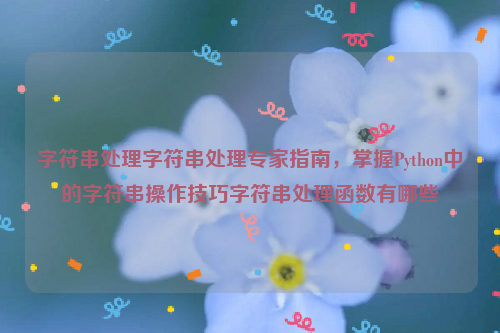在编程中,字符串处理是一个非常重要的技能,无论是在日常应用还是在实际项目中,我们都需要对字符串进行操作,以满足各种需求,本文将为您提供一个全面的字符串处理专家指南,帮助您掌握Python中的字符串操作技巧。
我们需要了解Python中的基本字符串类型,在Python中,字符串是由字符组成的有序集合,可以用单引号(' ')或双引号(" ")括起来。

str1 = 'hello' str2 = "world"
我们将介绍一些常用的字符串操作方法。
1、字符串拼接
要将两个字符串连接在一起,可以使用加号(+)操作符。
str3 = str1 + str2 # 结果为 'helloworld'
2、字符串分割
有时,我们需要将一个字符串按照某个分隔符分割成多个子字符串,可以使用split()方法实现。
str4 = 'hello,world'
words = str4.split(',') # 结果为 ['hello', 'world']3、字符串替换
我们需要将字符串中的某个子串替换为另一个子串,可以使用replace()方法实现。
str5 = 'hello world'
new_str = str5.replace('world', 'Python') # 结果为 'hello Python'4、字符串大小写转换
有时,我们需要将字符串中的字母转换为大写或小写,可以使用upper()和lower()方法实现。
str6 = 'Hello World' upper_str = str6.upper() # 结果为 'HELLO WORLD' lower_str = upper_str.lower() # 结果为 'hello world'
5、字符串去除空格
有时,我们需要去除字符串中的空格,可以使用strip()、lstrip()和rstrip()方法实现。
str7 = ' hello world ' new_str = str7.strip() # 结果为 'hello world'
6、字符串查找和替换所有匹配项
我们需要查找并替换字符串中的所有匹配项,可以使用find()、count()和replace()方法实现。
str8 = 'hello hello world' sub_str = 'hello' index = str8.find(sub_str) # 结果为 0,因为第一个'hello'的起始索引为0(从0开始计数) count = str8.count(sub_str) # 结果为 2,因为有两个'hello'出现在字符串中 new_str = str8.replace(sub_str, 'hi') # 结果为 'hi hi world',将所有的'hello'替换为'hi'
就是Python中常用的字符串操作方法,掌握这些方法后,您将能够更有效地处理字符串数据,在实际项目中,您可能还需要使用其他高级字符串操作技巧,如正则表达式等,但无论如何,这些基本的方法都将为您提供一个坚实的基础,帮助您在编程中游刃有余地处理字符串数据。





